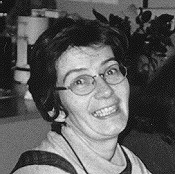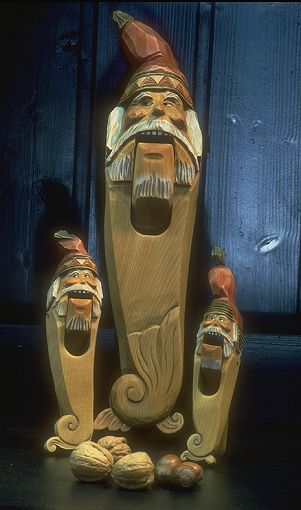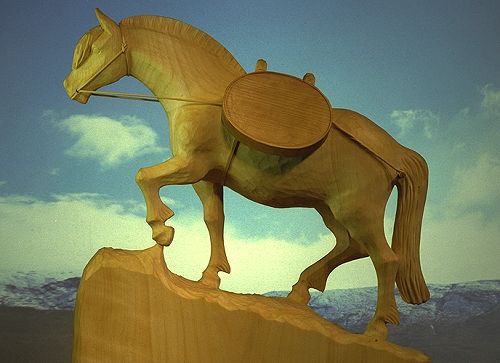A NORWEGIAN WOODCARVING FAMILY
by Arne Morkve,
Treskjerartunet, Norway
Email: arne.morkve@login.eunet.no
Visit Arne Morkve at: http://login.eunet.no/~arnemo2/index.htm
Woodcarver Ezine
Back Issues
Carvers'
Companion Gateway

| . |
A NORWEGIAN WOODCARVING FAMILYby Arne Morkve, Treskjerartunet, Norway Email: arne.morkve@login.eunet.no Visit Arne Morkve at: http://login.eunet.no/~arnemo2/index.htm Woodcarver Ezine 
|
| "TRESKJERARTUNET" is located in a valley in the western part of Norway, called Myrkdalen. It's a family- business with traditions in woodcarving. During the last years the business has gradually expanded, and has now four self-employed woodcarvers. Each has his/ her own articles, which include big and small in-the round pieces, nutcrackers, reliefs, traditional drinking-bowls,etc. |
| . | 
The FamilyThe artist Sjur Morkve, (Born Nov.18, 1917) in Voss, started carving sculptures as a young boy. He was born into an environment where home crafts were a natural part of daily life. His father, Odd, had artistic talents that he never really got to develop. Odd did some woodcarving when he was young, but in his days woodcarving wasn't considered a "proper" profession! Sjur started carving when was about ten years old. He often visited a well known woodcarver in the valley, Styrk Hirth, and learned much about ornamental carving in the Norwegian "dragon style" from him. There he got his first real carving tools, and guidance in how to carve nutcrackers, among other things. During the days he herded the goats, and had then plenty of time to carve. He had living models all around him, and here he carved his first goat sculptures, pieces which he makes even today. From 1953-55 he went to art school to learn more about classical ornamental carving. After graduating he then started his own workshop, and since then woodcarving has been his profession. When he first started, nutcrackers were his main product, all the year round. Sometimes, especially before Christmas, the whole family was involved in different tasks regarding the production of nutcrackers. In that way the children earned some extra money, which they then used to buy Christmas presents! Gradually other products became more popular, like the pack-horses and the goats. The production of nutcrackers declined and eventually stopped altogether. Today his pieces are more popular than ever. |
| . |  Geir Nymark (Born: March19,
1956) in Bergen, went to art school at Voss for two years, where
he met Bergfrid. At the time he gratuated in 1981 jobs were hard
to find in the district. With Sjur's guidance, he took
up the production of nutcrackers, which hadn't been made for
years. The demand for nutcrackers was good because Sjur
already had delivered them to retailers through many years, and
now there were nobody else that made such products. Even so,
the first year he ended up with an inventory, which he sold by
going around knocking doors the last days before Christmas! But
gradually he regained the market, and the nutcrackers have in
all the years after been his bread and butter. Geir Nymark (Born: March19,
1956) in Bergen, went to art school at Voss for two years, where
he met Bergfrid. At the time he gratuated in 1981 jobs were hard
to find in the district. With Sjur's guidance, he took
up the production of nutcrackers, which hadn't been made for
years. The demand for nutcrackers was good because Sjur
already had delivered them to retailers through many years, and
now there were nobody else that made such products. Even so,
the first year he ended up with an inventory, which he sold by
going around knocking doors the last days before Christmas! But
gradually he regained the market, and the nutcrackers have in
all the years after been his bread and butter.He has further developed the traditional, simple model and found his own style. In addition he also started making other sculptures, both of people and of animals: fiddlers, hillbillies, trolls, owls, penguins, and more. Norwegian ale bowls, "kjenge", is another of his products, using a traditional model, but with a new design. Geir's carving style is one of quick, somewhat rough cuts. He has also done some water color painting, much of which has been on comission. |
| . |  Bergfrid Morkve (Born: January 28,
1955) in Voss, is Sjur's daughter. She went to art school
at Voss for two years. There she learned ornamental carving.
She started as a woodcarver in the late 80's when she took part
in the production of nutcrackers, carving, painting and doing
the last "finish". She has gradually developed a range
of products herself, and is no longer involved in the production
of nutcrackers. Bergfrid solely carves human sculptures:
caricatures, Norwegian "hillbillies", human heads made
as corks for winebottles, etc. She has also done some restoration
work on old woodcarvings. Bergfrid Morkve (Born: January 28,
1955) in Voss, is Sjur's daughter. She went to art school
at Voss for two years. There she learned ornamental carving.
She started as a woodcarver in the late 80's when she took part
in the production of nutcrackers, carving, painting and doing
the last "finish". She has gradually developed a range
of products herself, and is no longer involved in the production
of nutcrackers. Bergfrid solely carves human sculptures:
caricatures, Norwegian "hillbillies", human heads made
as corks for winebottles, etc. She has also done some restoration
work on old woodcarvings. |
| . |  Arne Morkve, (Born: January 28, 1964)
in Voss, is Sjur's son. He took up carving in 1989. He
has no formal education within woodcarving. It's mainly been
learning by doing. The knowledge and experience of the others,
especially his father, has been crucial to his development as
a woodcarver. From the beginning he has made his own pieces,
and over the last years he has accumulated a variety of products.
Many of his pieces are of animals, domestic and foreign, and
some are of people as well. In addition to carved sculptures,
he also makes other products like drinking cups, dippers, nutcrackers,
wooden bookmarks, keyrings, etc. His style is a bit more "minute"
than the others', paying special attention to some focus-points,
like the eyes. Arne Morkve, (Born: January 28, 1964)
in Voss, is Sjur's son. He took up carving in 1989. He
has no formal education within woodcarving. It's mainly been
learning by doing. The knowledge and experience of the others,
especially his father, has been crucial to his development as
a woodcarver. From the beginning he has made his own pieces,
and over the last years he has accumulated a variety of products.
Many of his pieces are of animals, domestic and foreign, and
some are of people as well. In addition to carved sculptures,
he also makes other products like drinking cups, dippers, nutcrackers,
wooden bookmarks, keyrings, etc. His style is a bit more "minute"
than the others', paying special attention to some focus-points,
like the eyes. |
| . | 
The productionMaybe you want to know a bit about how we work. |
| . | 
The woodThe wood that we use is not very exotic. (Not to us anyway!) It's mainly birch; Norwegian, Swedish or Finish, it depends on where we buy it. It normally comes in 2'' or 3'' thickness. Which means that for the bigger pieces we have to laminate. Birch is what I would call a semi-hard wood. If it's straight-grown, not too old, and without too many knots, then it's excellent for carving. Providing you know how to keep your tools sharp; but of course, that applies to all types of wood. We've also used some black-Alder. It's softer than Birch, and a bit red in color. For a period of time my father and my brother in law used Lime a lot. It's even softer than Alder, and really needs very sharp tools to get a nice, smooth surface. |
| Packhorse (Sjur): The packhorse; of the old Norwegian breed: "fjordhest". They used it a lot in the old days. This was how they carried goods to and from the summer pastures in the mountains. An activity Sjur himself is well acquainted with from his younger days. |
| . |  |
| . |
FinishingAs for the finish, it differs from piece to piece. My father normally lets the wood stay "natural", i.e. he seldom paints or stain his works. But he often soaks the piece in oil, like for instance soybean-oil, to get a deeper color and more shiny surface. That's a technique we all use quite often. Some of the pieces we paint as well. The most important tool in this process is the airbrush, but we also use acrylics, color pencils, markers, pyrograph, basically whatever tool that gives the effect we're after. |
| Wedding (Bergfrid): Bergfrid depicts an traditional wedding
from the Voss district. Groom, bride and parents--they all seem quite thoughtful and somewhat taken by surprise, don't they? |
| . |  |
| . |
ReproductionsNormally we make the first sculpture as a model which we then use in a machine my father bought some twenty odd years ago. It a german "Reicenbacher" duplicarver, with which we can do eight roughouts a time using the "prototype" as a 3D model. It saves hours of work, and cuts the production costs dramatically. It has other advantages as well. It enables us to get to know an animal, for instance, through making it over and over again. I'm telling you, after making six eagles I was ready to throw away the first one! Even though I was quite happy with it when I made it. (Fortunately it was already sold :) ) |
| Eagle (Arne): The eyes are important in any carving of people or animals. Painted reflections helps to accentuate the gazing eyes of this eagle. |
| . |  |
| . |
Marketing our carvingsWe have a sales area and workshop in the same building. Of course, we try to sell as much as possible directly to the customers, because that's the most profitable way to do it. But we live a bit off the beaten track, so it's mainly during summertime that we have a steady visit of people, most of them tourists who are just passing through the valley. It's important that we have a range of products for these customers. Not every tourist wants to spend hundreds of dollars to be able to bring home some Norwegian craft! So, we also make more "tourist-friendly" products, like little owl-keyrings and wooden bookmarks. But then again, there are surprisingly many, both Norwegian and foreign tourists, who spend a considerable amount of money on bigger pieces as well. And they seem to be happy doing so; --- we certainly are! :) Our other important market is the gift-market where local customers who know about our business purchase our work. They often already know what piece they want before hand. My father's products are especially popular. After over 40 years in the local market, some of his pieces have become a "must" to many firms and organizations when they want to give a special something to one of their employees or business contacts. And private persons as well of course; they will often buy a pack horse for instance, as a present at birthdays or anniversaries. We all benefit from this market. The third market is the retailers market. Although selling directly to the customer is best, we don't as yet have the the amount of visitors during a year that's necessary to be able to sell all our production at the workshop. Not all the pieces are profitable enough to be sold in this manner though, because the retailing channels add a lot to the final cost of the product. Retailers normally expects considerable discounts. They will then double or triple the price when they sell it to their customers. The result is often that either the price we charge seems to high for the retailer to be satisfied, or it is to low for us to have an acceptable profit. But some products are well suited for this market. Geir, for instance, sells a lot of his nutcrackers this way. I've been carving for about seven and a half years now, and I really like this job. It allows me to be creative whenever I feel like it, adding new models to the collection one by one. And when I'm not feeling very creative ( it happens! ) I can do the routine "chores" on a piece that's been ordered, and that I know like the back of my hand. I guess my relation to woodcarving is a bit special since it's been my father's profession as long as I can remember. To me woodcarving wasn't at all exceptional, just another job, like sitting behind a desk from nine to five, or running a farm. Of course I got to try some carving when I grew up, but it wasn't until I was an adult that I began showing some real interest in the trade. Today we are four persons who work together at "Treskjerartunet". The valley in which we live is locally known as a place that's brought forth many artists through the years; famous fiddlers, blacksmiths, and woodcarvers. I think my father's well pleased to see that the tradition of woodcarving also is being passed on to future generations. |